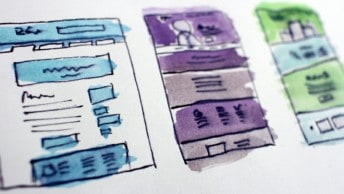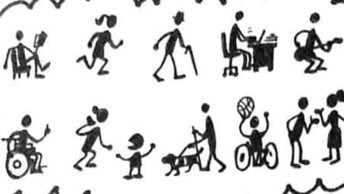As explained in part I of this two-part series, what we know about body language can help us conduct more fruitful UX research interviews. The key is to know what to look for.
Body language experts Barbara and Allan Pease have been researching this domain for over thirty years. In their book, The Definitive Book of Body Language, they reveal what many of us fail to recognise and understand when others try to communicate with us.
The Mirror Neuron
Research has identified a Mirror Neuron which attributes this behaviour to a physiological phenomenon. We are wired to mimic the reactions of those we interact with on a daily basis.
Unsurprisingly, scientists call this effect mirroring. It also works the other way around—a frown may yield a frown from the other party. Researcher Ulf Dimberg conducted experiments on 120 volunteers, measuring their facial muscle activity while viewing pictures of both happy and angry faces. When told to do the opposite of the pictures (e.g. smile while looking at a picture of an angry person) their facial twitching suggested that they were unconsciously trying to mirror the same reaction as the picture they were viewing, even though they were told to do the opposite.
While smiles are infectious, so are frowns and angry faces. After a long gruelling day of research it’s important for us as researchers to put on a happy face as best we can, even if it pains us to do so. Any hint of discontent might rub the participant the wrong way, making them feel bad or, even worse, neglected.
Strategic Gestures
Strategically smiling—knowing that the participant will likely smile back—sounds like you might be leading them, the way you are told not to when running a research session. But the tendency for humans to mirror one another’s gestures is so powerful that whether you remain neutral-faced or smiling, you’ll be leading them regardless.
The last thing you want a participant to do is to tell you what you want to hear. As a moderator, one of your primary goals is to make your participant feel comfortable enough to speak their mind about “the good, the bad, the ugly.” Gesturing positively builds the rapport required to get them feeling more at ease. Ultimately this will enable them to provide more truthful (and useful) information than they would if they were not relaxed.
Smiles reveal deeper aspects of human emotions. Not all smiles are created equal. Body language experts Barbara and Allan Pease describe 5 different types of smiles. Each of these has a different MO. Two of these smiles in particular may be useful to identify to help redirect UX research sessions.
The tight-lipped smile
The tight-lipped smile is when a person’s lips are stretched tight across their face in a straight line concealing their teeth. When you see this smile, there is a good chance that the person has a secret that they are unwilling to share with you.
During a UX research session, when you encounter this gesture, you might want to ask gently: “is there anything else you would like to share with me that you haven’t already mentioned?” This last part is important. It implies that as a keen observer you suspect there is something else that they are reluctant to share with you. Always reassure them whatever they share with you will not go beyond the research project.
Consider meeting them at their level by mirroring their facial gestures. This will demonstrate empathy for their situation. They will feel like they are being heard and understood. Making gestures that oppose their own could run the risk of coming across as antagonistic and apathetic. If they are smiling, you smile. If they are frowning, then frown with slight concern demonstrating your empathy and willingness to listen. Worst case scenario, they reject your request. Best case, they feel more comfortable sharing.
Always be mindful of them trying to please you as you empathise with their cause. Revert to a neutral stance whenever you feel like you are losing the candour from mirroring them.
The drop-jaw smile
Another common type of smile you may come across is the drop-jaw smile. This smile involves the person deliberately dropping their jaw to give the impression to others that they are laughing or are happy. It is commonly used by politicians to get votes, or actors to get a laugh from their audience. The drop-jaw smile is intended to get a positive reaction from its recipient.
One of the things I insert into my research protocols before beginning the main parts of my interview guide is requesting the participant tells me what they see, think and feel, not what they think I want to hear. Participants who deliver a drop-jaw smile might be trying to tell you what you want to hear. When you see this gesture during a session, do a sanity check with your participant. Make sure what they are telling you is their opinion and not someone else’s. They might say something like: well, I think people in my field would love to have a feature like this! Redirect and make the conversation about them: while it’s interesting to know that others would use this. How about you? How would you use a feature like this in your daily work?
Micro-gestures can tell us how a person really feels
According to body language experts it is very difficult to fake body language for long periods of time. Eventually the truth reveals itself in the form of micro-gestures. These are the body’s unconscious actions revealing themselves as a person’s conscious effort to conceal their authentic self weakens. It might be pupil dilation, facial muscle twitching, accelerated blinking, sweating, blushing, a momentary sneer. Research has shown that these micro-gestures occur within a split second and are very difficult to catch. As elusive as they are, the may provide some flag to a researcher that further investigation might be warranted.
During UX research sessions, look for changes in facial expressions.
Those brief flashes of concern or stress that sail across their face disappearing (as fast as they showed up) might suggest they may have more to share. It might be a pain point that could provide insight for your research effort,or an interesting anecdote that reveals an insight for your final report. Tread carefully though. Don’t acknowledge that you’ve picked up on the cue. Use it as a speed-bump to slow down. Wait for them to come forward with more info if they feel like it. Embrace any awkward silences that come your way. Those deliberate pauses give their micro-gestures a chance to breathe.
Understanding your participant’s body language ultimately allows you to build a better rapport and achieve a deeper level of empathy. View the signals offered up by gestures as opportunities to broaden your view of their reality and gain insights for your research.
References;
Dimberg, U., Thunberg, M., Elmehed, K., “Unconscious facial reactions to emotional facial expressions,” Psychological Science 11 (2000).
Pease, A., & Pease, B. (2006). The Definitive Book of Body Language. New York: Bantam Dell Pub Group.







